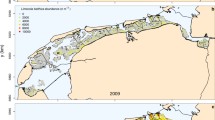Abstract
The effects of subsampling and of the variation within and among sampling stations on the accuracy of the estimates of mean population densities for copepods and cladocerans are examined. For the computation of the coefficient of variation in the mean, the sample variance of log transformed data is appropriate. Accuracy is primarily influenced by variation between sampling stations and to a lesser extent by the variation within a sampling station, while subsampling variation has only a minor effect on the accuracy as long as more than 25 individuals per subsample are counted.
Similar content being viewed by others
References
Beattie, D. M., H. L. Golterman & J. Vijverberg, 1978. An introduction to the Limnology of the Friesian Lakes. Hydrobiologia 58: 49–64.
Bottrell, H. H., A. Duncan, Z. M. Gliwicz, E. Grygierek, A. Herzig, H. Kurasawa, P. Larsson & T. Weglenska, 1976. A review of some problems in zooplankton production studies. Norw. J. Zool. 24: 419–456.
Cassie, R. M., 1962. Frequency distribution models in the ecology of plankton and other organisms. J. anim. Ecol. 31: 65–92.
Conquest, L. L., 1983. Assessing the statistical effectiveness of ecological experiments: Utility of the coefficient of variation. Int. J. envir. Stud. 20: 209–221.
Duncan, A., 1975. The importance of zooplankton in the ecology of reservoirs. Pap. Proc. Wat. Res. Cent. Symp. Effects of Storage on Wat. Qual., Wat. Res. Cent., Medmemham: 248–272.
Evans, M. S. & D. W. Sell, 1983. Zooplankton sampling strategies for environmental studies. Hydrobiologia 99: 215–223.
Hall, D. J., W. E. Cooper & E. E. Werner, 1970. An experimental approach to the production dynamics and structure of freshwater animal communities. Limnol. Oceanogr. 15: 839–929.
Hutchinson, G. E., 1957. A Treatise on Limnology, 1. Geography, physics and chemistry. Wiley-Interscience, N.Y., 1015 pp.
Hutchinson, G. E., 1967. A Treatise on Limnology, 2. Introduction to lake biology and limnoplankton. Wiley-Interscience, N.Y., 1115 pp.
Karabin, A., 1971. A comparison of two methods of sampling the plankton predator Leptodora kindtii (Focke) (Crustacea, Cladocera). Bull. Acad. pol. Sci. 2. Ser, Sci. biol. 19: 197–200.
Kott, P., 1953. Modified whirling apparatus for subsampling of plankton. Aust. J. mar. Freshwat. Res. 4: 387–397.
Langeland, A. & S. Rognerud, 1974. Statistical analyses used in the comparison of three methods of freshwater zooplankton sampling. Arch. Hydrobiol. 73: 403–410.
Larsson, P., 1978. The life cycle dynamics and production of zooplankton in Ovre Heimdalsvatn. Holarct. Ecol. 1: 162–218.
Milbrink, G., 1968. A microstratification sampler for mud and water. Oikos 19: 105–110.
Morgan, N. C., 1980. Secondary production. In E. D. Le Cren & R. H. Lowe-McConnel (eds.), The functioning of freshwater ecosystems. Int. biol. Progm 22. Cambridge University Press, Cambridge: 247–340.
Nie, H. W., de, H. J. Bromley & J. Vijverberg, 1980. Distribution patterns of zooplankton in Tjeukemeer, The Netherlands. J. Plankton Res. 2: 317–334.
Patalas, K., 1954. Comparative studies on a new type of selfacting watersampler for plankton and hydrochemical investigation. Ekol. pol. 2: 231–242 (in polish, English summary).
Schindler, D. W., 1969. Two useful devices for vertical plankton and water sampling. J. Fish. Res. Bd Can. 26: 1948–1955.
Sell, D. W. & M. S. Evans, 1982. A statistical analysis of subsampling and an evaluation of the Folsom plankton splitter. Hydrobiologia 94: 223–230.
Sokal, R. R. & F. J. Rohlf, 1969. Biometry. The principles and practice of statistics in biological research. Freeman Cooper & Co., S. Francisco, 776 pp.
Vijverberg, J. & A. F. Richter, 1982a. Population dynamics and production of Acanthocyclops robustus (Sars) and Mesocyclops leuckarti (Claus) in Tjeukemeer, The Netherlands. Hydrobiologia 95: 261–274.
Vijverberg, J. & A. F. Richter, 1982b. Population dynamics and production of Daphnia hyalina Leydig and Daphnia cucullata Sars in Tjeukemeer, The Netherlands. Hydrobiologia 95: 235–259.
Author information
Authors and Affiliations
Rights and permissions
About this article
Cite this article
de Nie, H.W., Vijverberg, J. The accuracy of population density estimates of copepods and cladocerans, using data from Tjeukemeer (the Netherlands) as an example. Hydrobiologia 124, 3–11 (1985). https://doi.org/10.1007/BF00011391
Received:
Revised:
Accepted:
Published:
Issue Date:
DOI: https://doi.org/10.1007/BF00011391




